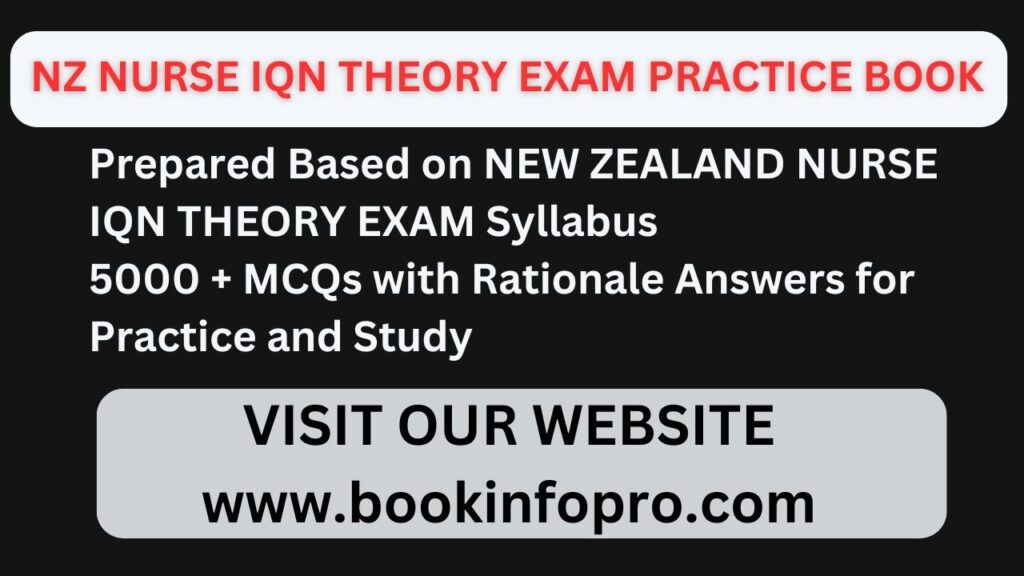NEW ZEALAND IQN EXAM QUESTION – Safe and Effective Environments Nursing Care MCQs
Theoretical Exam Preparation: This video helps to prepare and improve your confidence with solved question papers, IQN related MCQs. Examination structure The examination questions are designed to assess knowledge which is required to practise safely as a nurse in Aotearoa New Zealand. The scope of the questions in each part of the examination are:
Part A: Medication Safety – medication and fluid safety questions including medicine calculations.
Part B: Nursing Knowledge – questions are closely linked to the Council’s registered nurse competency domains: • professional responsibility – questions include but are not limited to: ethical/legal safety, culturally safe care, delegation/supervision, and safe and effective environments and practice. • management of nursing care – questions include but are not limited to: assessment, prioritising, decision making, planning, delivery and evaluation of nursing care, infection prevention and control, medication/fluid safety, vaccination/immunisation, long term condition management, deteriorating patient, consumer rights and advocacy, patient and whānau/family education, and health promotion. Interpersonal relationships and interprofessional healthcare – questions include but are not limited to: therapeutic relationships/partnership, health team relationships, and records management/information exchange.
Question 1: What is the best way to prevent the spread of infection in a healthcare setting?
a) Hand hygiene
b) Wearing gloves for all procedures
c) Sterilizing all equipment daily
d) Using antibiotics prophylactically
Answer: a) Hand hygiene
Explanation: Hand hygiene, including regular handwashing and use of hand sanitizers, is the most effective way to prevent the spread of infection.
Question 2: What is the primary purpose of using a “no lift” policy in a healthcare setting?
a) To prevent injuries to healthcare workers
b) To reduce patient discomfort during transfers
c) To decrease the number of staff required for patient care
d) To minimize equipment costs
Answer: a) To prevent injuries to healthcare workers
Explanation: A “no lift” policy helps prevent musculoskeletal injuries among healthcare workers by using assistive devices for patient transfers.
Question 3: What is the first step a nurse should take if they find a patient on the floor after a fall?
a) Assess the patient for injuries
b) Call for help immediately
c) Document the incident
d) Help the patient back to bed
Answer: a) Assess the patient for injuries
Explanation: The priority is to assess the patient for injuries to determine the appropriate next steps in care.
Question 4: Which of the following is an example of a medication error?
a) Administering medication to the wrong patient
b) Giving a medication at the correct dose and time
c) Administering a placebo during a clinical trial
d) Checking a medication order for accuracy before administration
Answer: a) Administering medication to the wrong patient
Explanation: Administering medication to the wrong patient is a medication error that can have serious consequences.
Question 5: A nurse is preparing to administer an IV medication but notices the packaging is damaged. What should the nurse do?
a) Discard the medication and obtain a new dose
b) Administer the medication if it looks safe
c) Contact the pharmacy for guidance
d) Report the issue to the charge nurse
Answer: a) Discard the medication and obtain a new dose
Explanation: Damaged packaging could indicate contamination or compromised medication; always use a new dose to ensure safety.
NEW ZEALAND IQN NURSE THEORY EXAM PRACTICE BOOK
Question 6: A healthcare facility conducts regular safety drills. What is the primary purpose of these drills?
a) To ensure staff know how to respond in emergencies
b) To fulfill legal requirements for facility safety
c) To evaluate the performance of emergency equipment
d) To identify potential safety hazards in the facility
Answer: a) To ensure staff know how to respond in emergencies
Explanation: Safety drills prepare staff to respond appropriately in emergencies, ensuring patient and staff safety.
Question 7: A nurse observes a colleague not following standard precautions when handling bodily fluids. What is the most appropriate response?
a) Remind the colleague about standard precautions
b) Report the incident to a supervisor
c) Ignore the incident to avoid conflict
d) Correct the colleague’s behavior publicly
Answer: a) Remind the colleague about standard precautions
Explanation: Providing a gentle reminder promotes safety and teamwork without causing public embarrassment.
Question 8: Which of the following is a common cause of patient falls in healthcare settings?
a) Medication side effects
b) Well-maintained flooring
c) Proper use of assistive devices
d) Adequate lighting in hallways
Answer: a) Medication side effects
Explanation: Medication side effects, such as dizziness or confusion, are a common cause of patient falls.
Question 9: What is the best way to prevent medication errors related to “look-alike, sound-alike” drugs?
a) Using tall-man lettering to differentiate similar drug names
b) Storing these drugs in separate areas
c) Double-checking medication orders before administration
d) All of the above
Answer: d) All of the above
Explanation: These are common strategies to prevent medication errors involving “look-alike, sound-alike” drugs.
Question 10: A nurse finds a sharps container that is overfilled. What is the best course of action?
a) Replace the sharps container with a new one
b) Continue using the container until it is completely full
c) Compress the contents to create more space
d) Remove the sharps manually and reinsert them properly
Answer: a) Replace the sharps container with a new one
Explanation: Overfilled sharps containers pose a risk of needlestick injuries and should be replaced promptly.
SEO SEARCH
#medicationmcq #practicenursemcq #culturallysafecarenursing #decisionmaking #nursingdecisionmaking #nursingassessment #assessment #medicationsafetymcq #medicationsafety #iqn #drugdosagefornurses #drugdosagecalculations #drugdosage #newzealandurses #nursingknowledge #nursingknowledgemcq #drugcalculationmcq #drugcalculation #medicinecalculationmcq #drugcalculationfornurses #solvedquestionpaper #NursingPracticeQuestions #StaffNurseExam2024 #nurseinfocanestar #SolvedQuestionPaper #StaffNurseMCQ #PharmacologyMCQ #CriticalCareNursingMCQ #PediatricNursingMCQ #ObstetricNursingMCQ #PsychiatricNursingMCQ #GerontologicalNursingMCQ #MentalHealthNursingMCQ #nursingresponsibility #fluidsafetymcq #nursingresponsibilitymcq #nursingmanagement #medicationsafetymcq #nursingmanagementmcq #nursingcare #nursingcaremcq #ethicalandlegalnursingmcq #nzethicalandlegalnursingmcq #delegationnursingmcq #supervisonnursingmcq #longtermconditionmanagementmcq #longterm #longtermhealth #longtermdisease #mcqs #newzealandurses #newzealand #nursingplanning #nursingcareplan #nurseplan #nursingcareplanningmcq #patienteducation #whanau #whānau #patientfamilyeducation #vaccination #immunization #vaccinationmcq #immunizationmcq #nursingrecords #nursingreport #record #recordmanagement #recordmanagementmcq #therapeutic #therapeuticrelationship #therapeuticcommunication #therapeuticmcq #therapeuticquiz #healthpromotion #healthpromotionmcq #healthpromotionquiz #nursinghealthpromotion #information #informationexchange #informationexchangemcq #nursinginformationexchangemcq #mcqs #newzealandmcqs #previousyearquestions #samplequestionpaper #sample #newzealandpreviousyearquestionpaper #iqnmocktest #nziqnmocktest #newzealandiqnmocktest

